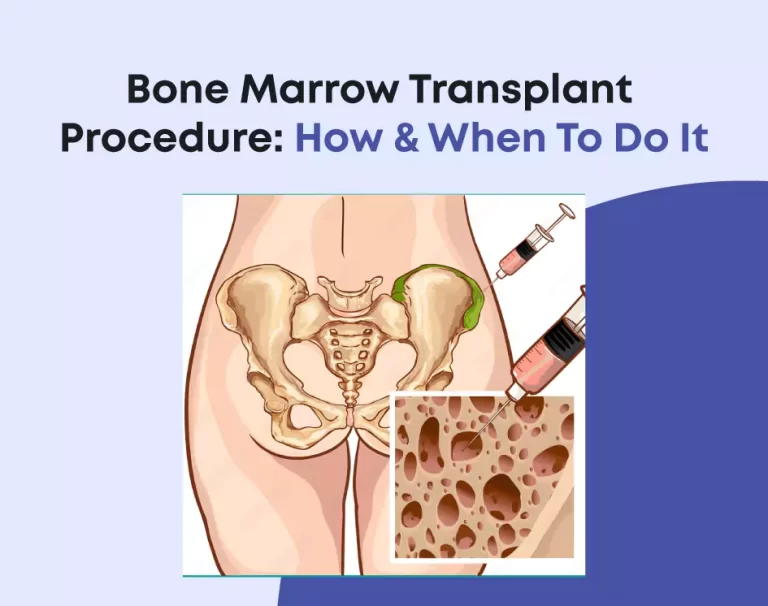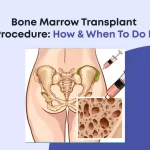
Bone Marrow Transplant Procedure: How & When To Do It?
Are you facing a diagnosis that may require a bone marrow transplant? If so, you should understand the procedure, its timing, and what to expect. Doing this can help alleviate some of the anxiety surrounding this life-saving treatment. A bone marrow transplant is referred to as a stem cell transplant. It is a procedure where damaged or diseased bone marrow is replaced with healthy stem cells. This treatment can be a critical option for individuals with conditions like leukemia, lymphoma, or certain genetic disorders. In this guide, we’ll learn what the bone marrow transplant procedure is and how it’s done.
Understanding Bone Marrow Transplant
Bone marrow is the soft and spongy tissue nestled within bones. It is essential for producing white blood cells, red blood cells, and platelets. These cells are necessary for various bodily functions, such as oxygen transportation, immune response, and blood clotting. However, certain diseases and conditions can compromise the bone marrow. This further can affect its ability to produce healthy blood cells, leading to serious health complications.
What is a Bone Marrow Transplant?
Another name for bone marrow transplant is stem cell transplant. This medical procedure aims to replace damaged or diseased bone marrow with healthy stem cells. Stem cells are immature cells capable of developing into various types of blood cells.
Types of Bone Marrow Transplant
Below, we have discussed two types of bone marrow transplant:
Autologous Transplant
The patient’s stem cells are gathered and preserved in this type of transplant. This is done before undergoing chemotherapy or radiation treatment. Following treatment, the preserved stem cells are reintroduced back into the patient’s body, where they work to regenerate healthy bone marrow.
Allogeneic Transplant
In an allogeneic transplant, stem cells are sourced from a compatible donor. Typically, a close family member or unrelated donor whose tissue type closely matches that of the patient donates the stem cells. These donated stem cells are then infused into the patient’s bloodstream. Here, they migrate to the bone marrow and produce new blood cells.
Conditions Treated with Bone Marrow Transplant
Bone marrow transplants are commonly used to treat various types of blood cancers. This includes leukemia, lymphoma, and multiple myeloma. Additionally, they may be used to treat non-cancerous conditions such as aplastic anemia. In this case, the bone marrow fails to produce adequate blood cells.
Understanding the fundamentals of bone marrow transplant provides a foundation for further exploring the procedure’s intricacies.
Preparing for a Bone Marrow Transplant
The bone marrow transplant preparation involves several vital steps to ensure the best possible outcome for the patient. Here it is:
Medical Evaluation
Before undergoing a bone marrow transplant, patients undergo a thorough medical evaluation. By this, doctors assess their overall health and determine their suitability for the procedure. This evaluation typically includes a physical examination, blood tests, imaging studies, and other specialized tests. These all evaluate organ function and identify any underlying health issues that may affect the transplant process.
Donor Matching
For patients undergoing an allogeneic transplant, finding a suitable donor is a critical step. Donors are typically matched based on human leukocyte antigen (HLA) markers. Here, proteins found on the surface of cells play a key role in the body’s immune response. The closer the match between donor and recipient, the lower the risk of complications such as graft-versus-host disease (GVHD). In the case of GVHD, the donor’s immune cells attack the recipient’s tissues.
Conditioning Regimen
Before receiving the transplant, patients undergo a conditioning regimen. This process may involve chemotherapy, radiation therapy, or a combination of both. This regimen destroys any remaining cancer cells or abnormal bone marrow cells in the patient’s body. Besides, it suppresses the immune system to prevent rejection of the transplanted cells. The specific regimen may vary depending on the patient’s diagnosis, overall health, and other factors. Adequate preparation is essential for optimizing the chances of a successful bone marrow transplant.
The Bone Marrow Transplant Procedure
The bone marrow transplant procedure involves several key stages, each crucial to the transplant’s success.
Harvesting Stem Cells
In an autologous transplant, the patient’s stem cells are typically collected from their bloodstream using apheresis. During apheresis, blood is drawn from the patient’s body. Afterward, it is passed through a machine that separates the stem cells. Then, it is returned to the patient’s body. In an allogeneic transplant, stem cells may be collected from the donor’s bloodstream using a similar process or directly from their bone marrow.
Transplant Process
Once the stem cells have been collected, they are infused into the patient’s bloodstream through a catheter, similar to receiving a blood transfusion. The stem cells then travel to the bone marrow, where they settle, grow, and produce new blood cells.
Engraftment
The engraftment phase occurs when the transplanted stem cells take root in the patient’s bone marrow and produce healthy blood cells. This process typically takes several weeks. Patients may experience low blood cell counts and an increased risk of infection and bleeding during this time.
Monitoring and Supportive Care
Patients receive close monitoring by a multidisciplinary medical team throughout the transplant process. It covers physicians, nurses, and other healthcare professionals. This monitoring helps identify and manage any complications, such as infections, graft failure, or GVHD. Moreover, patients may receive supportive care measures such as blood transfusions, antibiotics, and medications to manage symptoms and side effects.
The step-by-step process of a bone marrow transplant provides insight into its complexity and potential challenges.
Recovery and Aftercare of Bone Marrow Transplant
Recovery from a bone marrow transplant is a gradual process that requires ongoing medical supervision and support.
Hospitalization and Monitoring
Following the transplant, patients typically remain hospitalized for an extended period. This is done to receive close monitoring and management of any potential complications. Patients undergo frequent blood tests and other assessments to monitor their blood cell counts, organ function, and overall health.
Immune System Recovery
One of the most critical aspects of recovery is the gradual rebuilding of the patient’s immune system. After the transplant, patients are at increased risk of infections due to low white blood cell counts. They may need to take precautions such as avoiding crowded places and practicing good hygiene. It may take several months to a year for the immune system to fully recover. During this time, patients may need to continue taking medications to prevent infections and manage GVHD.
Long-term Follow-up
Even after leaving the hospital, patients require ongoing medical follow-up. This will monitor their progress and detect any potential complications early. Regular appointments with a transplant specialist and other healthcare providers such as hematologists and infectious disease specialists are essential. It will ensure the patient’s long-term health and well-being.
Closing Thoughts
A bone marrow transplant can be a life-saving treatment for individuals with certain blood cancers and other serious conditions affecting the bone marrow. By understanding it, patients and their families can approach the transplant process with confidence and optimism. The journey may be challenging, with the support of healthcare professionals, loved ones, and resources available. Meanwhile, patients can navigate the road to recovery with resilience and hope.








